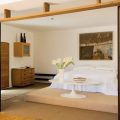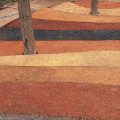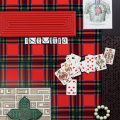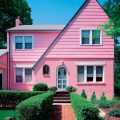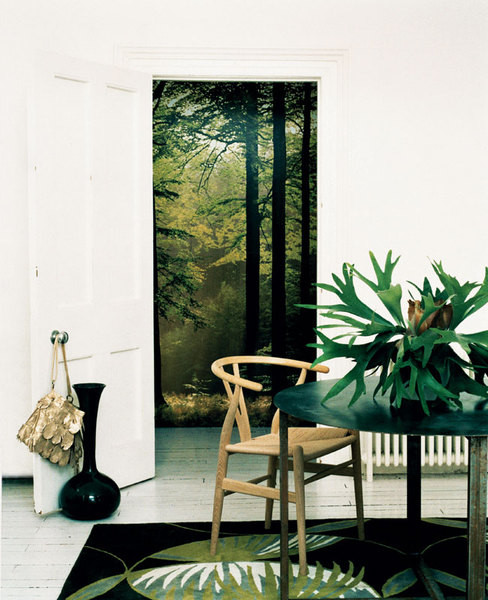 Design by plants Nature does not tolerate emptiness. Take an example from her: declare war on dull bare walls and decorate them with photo wallpapers of nature. Take as a basis a picture taken during a walk in the woods or an illustration from an album, and then contact a company that deals with large-format digital printing (for example, www.maximuc.ru, www.fotoproject.ru). Professionals will scan the image, if necessary, retouch it and make an imprint of the desired format on paper or self-adhesive film. You have little nature in the photo? Then add to a couple of potted plants!
Design by plants Nature does not tolerate emptiness. Take an example from her: declare war on dull bare walls and decorate them with photo wallpapers of nature. Take as a basis a picture taken during a walk in the woods or an illustration from an album, and then contact a company that deals with large-format digital printing (for example, www.maximuc.ru, www.fotoproject.ru). Professionals will scan the image, if necessary, retouch it and make an imprint of the desired format on paper or self-adhesive film. You have little nature in the photo? Then add to a couple of potted plants!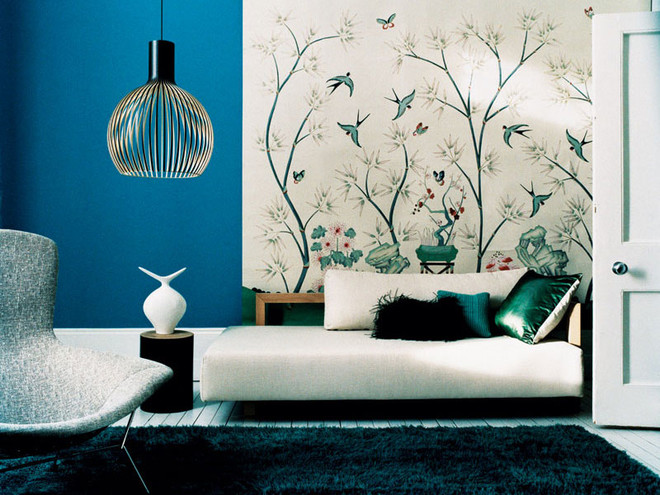 The device of a winter garden business troublesome. But if instead of living plants to use wallpaper with a floral pattern, the task is much simpler. Chinoiseries with tropical flowers and paradise birds (similar to the ones in the collection of De Gournay) will be refreshed by even the most discreet interior. To enhance the invigorating effect, place the panel on a contrasting background (the wall in the photo is painted in a soothing blue with Turquoise Parade 1, Dulux), and then complement it with a pair of accessories in the color of fresh greenery and a grass-like carpet.
The device of a winter garden business troublesome. But if instead of living plants to use wallpaper with a floral pattern, the task is much simpler. Chinoiseries with tropical flowers and paradise birds (similar to the ones in the collection of De Gournay) will be refreshed by even the most discreet interior. To enhance the invigorating effect, place the panel on a contrasting background (the wall in the photo is painted in a soothing blue with Turquoise Parade 1, Dulux), and then complement it with a pair of accessories in the color of fresh greenery and a grass-like carpet.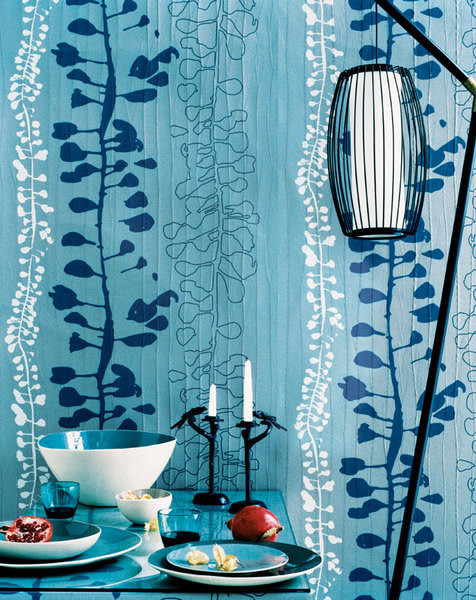 Vertical gardening is in fashion these days.The facades of the houses are covered with ivy and wild grapes, and the walls of the rooms are adorned with "plants" bred by one of the world's best designers. The pattern of the Scala wallpaper, created by Ulf Moritz for the Sahco brand, has no prototypes in nature, but it still looks very convincing. Paste this wallpaper over the dining room, and it will turn into a kind of open terrace, entangled with shoots of some unknown liana. To make the unity with nature even more acute, set the table with simple handmade ceramics.
Vertical gardening is in fashion these days.The facades of the houses are covered with ivy and wild grapes, and the walls of the rooms are adorned with "plants" bred by one of the world's best designers. The pattern of the Scala wallpaper, created by Ulf Moritz for the Sahco brand, has no prototypes in nature, but it still looks very convincing. Paste this wallpaper over the dining room, and it will turn into a kind of open terrace, entangled with shoots of some unknown liana. To make the unity with nature even more acute, set the table with simple handmade ceramics.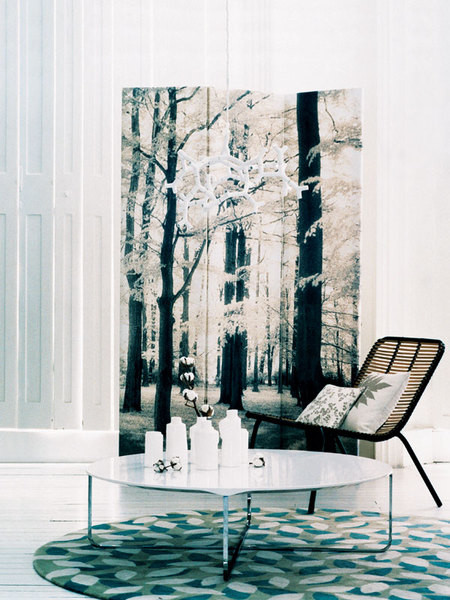 If the onset of cold weather does not scare you, but,On the contrary, it is pleasing that the long-awaited meeting with winter can be brought closer by means of decor. Custom-printed photo wallpaper with a view of an autumn forest and an island of fallen leaves (this role will be played by a carpet) in the center of the room eloquently say that summer is long gone. A good background for these "remnants of former luxury" will be white walls and floor - they seem to be sprinkled with the first snow.
If the onset of cold weather does not scare you, but,On the contrary, it is pleasing that the long-awaited meeting with winter can be brought closer by means of decor. Custom-printed photo wallpaper with a view of an autumn forest and an island of fallen leaves (this role will be played by a carpet) in the center of the room eloquently say that summer is long gone. A good background for these "remnants of former luxury" will be white walls and floor - they seem to be sprinkled with the first snow.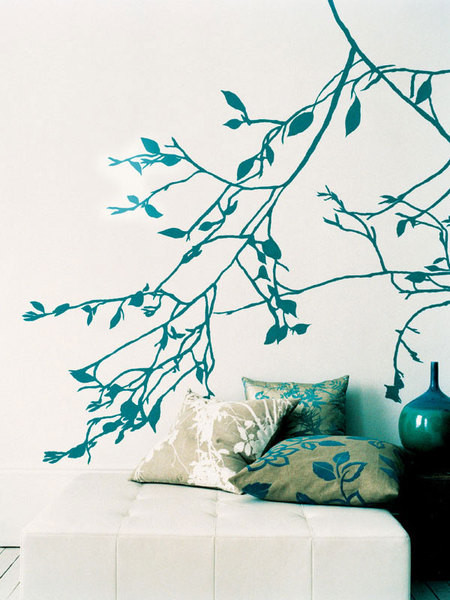 You can bask in the shade of the trees even after sunsetsun. Provided that this shadow is drawn. There are three ways to transfer the image of a branch to the wall. The first method is the simplest: take some paint, brushes and just draw a branch as God puts it into your soul. The second method is high-tech: take a photo of the branch and contact specialists in plotter cutting (www.apelsinrg.ru, www.vdprint.ru, etc.). They will make a silhouette of the required size from self-adhesive film. The third method is the most labor-intensive: print the image of the branch on photographic film, project it onto the wall (you will need a special projector with a fan so that the film does not burn), trace its contour with a pencil, and then paint it.
You can bask in the shade of the trees even after sunsetsun. Provided that this shadow is drawn. There are three ways to transfer the image of a branch to the wall. The first method is the simplest: take some paint, brushes and just draw a branch as God puts it into your soul. The second method is high-tech: take a photo of the branch and contact specialists in plotter cutting (www.apelsinrg.ru, www.vdprint.ru, etc.). They will make a silhouette of the required size from self-adhesive film. The third method is the most labor-intensive: print the image of the branch on photographic film, project it onto the wall (you will need a special projector with a fan so that the film does not burn), trace its contour with a pencil, and then paint it.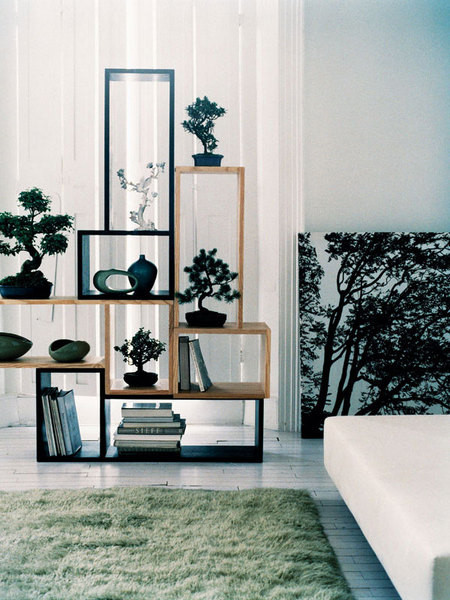 Our carpet is a flower meadow.Today, these words take on a new meaning! The bright green angora rug from Rug Company looks like a forest edge. For those who want to delve deeper into the forest, we recommend decorating the interior with bonsai trees and a panel made of Tuuli fabric, designed by Maija Isola for Marimekko. It is not necessary to paint the ceiling blue to make it resemble a cloudless sky. But the walls can be painted blue, it will not harm them.
Our carpet is a flower meadow.Today, these words take on a new meaning! The bright green angora rug from Rug Company looks like a forest edge. For those who want to delve deeper into the forest, we recommend decorating the interior with bonsai trees and a panel made of Tuuli fabric, designed by Maija Isola for Marimekko. It is not necessary to paint the ceiling blue to make it resemble a cloudless sky. But the walls can be painted blue, it will not harm them.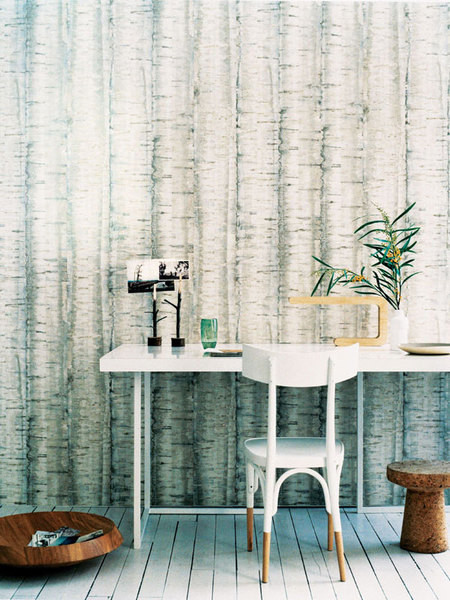 Nature does not obey other people's rules —She dictates hers. And why are you worse? Forget about stereotypes and use flooring for wall decoration. The wall is covered with laminate from the Papyrus collection, Pergo. If you fundamentally do not let artificial materials into your home, decorate the walls with photo wallpaper with a similar image. Russophiles can replace exotic papyrus with more patriotic birch bark. For the sake of returning to nature, it is not a sin to sacrifice the achievements of progress. Give up modern digital photography in favor of antediluvian cyanotype. This method of obtaining prints was invented in the middle of the 19th century and has hardly changed since then. To create a cyanotype, you will need solutions of potassium ferrocyanide (10 g per 100 ml of water) and iron salt of ammonium citric acid (25 g per 100 ml of water). These substances can be purchased at a store selling chemical reagents. You should work with them in rubber gloves and a mask to protect your face. Mix both liquids in a glass container, soak a sheet of paper and wait for it to dry. Place the branch on the paper and expose it to the sun for about 30 minutes (the longer, the more contrast the image will have). Rinse the paper and dry it. The cyanotype is ready. Stylist: Emma Thomas Photo: Adrian Briscoe
Nature does not obey other people's rules —She dictates hers. And why are you worse? Forget about stereotypes and use flooring for wall decoration. The wall is covered with laminate from the Papyrus collection, Pergo. If you fundamentally do not let artificial materials into your home, decorate the walls with photo wallpaper with a similar image. Russophiles can replace exotic papyrus with more patriotic birch bark. For the sake of returning to nature, it is not a sin to sacrifice the achievements of progress. Give up modern digital photography in favor of antediluvian cyanotype. This method of obtaining prints was invented in the middle of the 19th century and has hardly changed since then. To create a cyanotype, you will need solutions of potassium ferrocyanide (10 g per 100 ml of water) and iron salt of ammonium citric acid (25 g per 100 ml of water). These substances can be purchased at a store selling chemical reagents. You should work with them in rubber gloves and a mask to protect your face. Mix both liquids in a glass container, soak a sheet of paper and wait for it to dry. Place the branch on the paper and expose it to the sun for about 30 minutes (the longer, the more contrast the image will have). Rinse the paper and dry it. The cyanotype is ready. Stylist: Emma Thomas Photo: Adrian Briscoe

Making Money with Desserts: Success Stories
Evgeniya Polischuk (Fedutinova) instagram:@evgeniyafedutinovavk.com/janeshomebaking– It all started with baking for family and friends. Gradually, I started posting photos of my baked goods on Instagram – and orders started coming in. I made my first custom-made cake on October 13, 2014, and a little earlier I started making macaroons and cupcakes. You could say that the business “found me”, I am very […]

Soups are cold recipes with photos
Cold cucumber soup with yogurt and lemonsorbet from the chef of the restaurant La Taverna Alexander Zhurkin Photo: Getty Images Ingredients: Plain yoghurt – 125 g Cucumber – 150 g Lemon/lime sorbet – 50 g Cocktail shrimp – 24 g Fresh ginger juice – 1 g Lime juice – 5 g Fresh orange juice – 5 g Parsley – 1 g Pink pepper – 1 g Watercress – […]

barbeque kebab
Pork tenderloin in glaze Photo:Dmitry Bayrak/dbstudioPreparation time: 20 minutes + marinating time.Calories: 454 kcal per serving.For 4 servings: 4 pork tenderloins (approximately 300 g each), 1 onion, 2 cloves of garlic, 1 tsp. lemon zest, 1 tsp. lemon juice, a pinch of ground cumin, coriander and turmeric, 1 tbsp. vegetable […]

Pierre Duacan: dietary recipes: Ducane diet
Beetroot soup Photo:Season’S, Luxury Hotels RepresentationYou will need:· Boiled beetroot – 60 g· Fresh cucumbers – 20 g· Red radish – 20 g· Green onions – 10 g· Egg – 1 pc.· Drinking mineral water – 200 g· Salt – 1 gPreparation:· Boil the egg and beetroot.· Grate the cucumbers, radish and part of the beetroot. Put everything […]

